
The House of the Infantado (Portuguese: Casa do Infantado) was an appanage for the second eldest son of the Portuguese monarch.

The House of the Infantado (Portuguese: Casa do Infantado) was an appanage for the second eldest son of the Portuguese monarch.
The House of the Infantado was created in 1654 by King John IV of Portugal from properties and riches confiscated from the Marquis of Vila Real, supporters of House of Habsburg during the Portuguese Restoration War. It belonged to and was passed on to the second-born son of each King — i.e., the Infante that was not entitled to the crown — as his appanage. This member of the Portuguese royal family was known as the Lord of the House of the Infantado (Senhor da Casa do Infantado) or simply the Lord of the Infantado (Senhor do Infantado).
The measure was intended to "perpetuate and extend as much as possible the blood of the royal family." The extinction of the House of Aviz in 1580 had brought the Kingdom of Portugal in personal union with Spain, de facto subjecting the country to Spanish rule. Thus the country's independence depended also on the fertility of the royal house. With a large income, second sons are encouraged to marry to produce cadet branches capable of perpetuating the royal line.
The basis of the donation was the city of Beja, with the ducal title, which belonged to King Manuel I of Portugal. As this income was not enough, the lands Vila Real and Caminha, confiscated in 1641, were added to it.
The donation covered the villages, places, castles, padroados, land, forums, rights and duties for the second house, which guaranteed the title of Duke of Vila Real to the eldest son of Infante Dom Pedro. The House continued to receive new grants from the crown: the fifth of Queluz and their appurtenances; the palaces and houses of Corte-Real in Lisbon, which had belonged to the 2nd Marquis of Castelo Rodrigo; the town of Serpa and with their barns and de Moura; rents of the Military Order of Christ to which the infante had been named Commander; the marshlands of Golegã, Borba, Mouchões and Silveira, near the Tagus river, from São Liborio to Santarém; saboarias of Porto and villages and places of Entre Douro and Minho and Tras-os-Montes.
Other favors were added after the accession of Afonso VI, giving Dom Pedro an annual grant of 1000 quintals of Brazil wood without payment of duties; and the purchase that he made from his sister, Queen Catherine of Braganza, of the city of Lamego and the marsh of Magos.
Thus, it was not just dominial extension defining the House of Infantado, but the whole of their income in vast urban and rural areas from Tras-os-Montes to Alentejo. Its main wealth was agricultural, but also benefited from maritime interests (Caminha, Aveiro) and rivers. Thus, after the King of Portugal and the Prince of Brazil, the Infantado was the wealthiest household in the Kingdom in terms of seigneurial demesnes.
The primary purpose of the appanage was to enrich the secundogeniture infante with a source of income that would allow him to retain the status expected of a prince. However, the enormous wealth became a source of strife and discord as it did on the death of the Infante Francisco, Duke of Beja, brother of King John V in 1742. The next younger brother of the King, Dom António, claimed the succession to the House of Infantado, which was instead given to the second son of King John V, which greatly worsened the relationship between the two brothers.
The following estates were part of the Casa do Infantado:
| Name | Lifespan | Tenure | Notes | Parents | Image |
|---|---|---|---|---|---|
| Pedro | 26 April 1648 – 9 December 1706 | 1645 - 1683 | Also: Duke of Beja Later: King Peter II of Portugal and the Algarves | John IV of Portugal Luisa de Guzmán |  |
| Francisco | 25 May 1691 - 21 July 1742 | 1696 - 1742 | Also: Duke of Beja | Peter II of Portugal Maria Sophia of Neuburg | 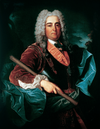 |
| Pedro | 5 July 1717 – 25 May 1786 | 1742 - 1777 | Later: King Peter III of Portugal and the Algarves | John V of Portugal Maria Anna of Austria |  |
| João | 13 May 1767 – 10 March 1826 | 1777 - 1788 | Later: King John VI of Portugal and the Algarves | Maria I of Portugal Peter III of Portugal |  |
| Miguel | 26 October 1802 – 14 November 1866 | 1802 - 1824 | Later: King Miguel I of Portugal and the Algarves | John VI of Portugal Carlota Joaquina of Spain |  |
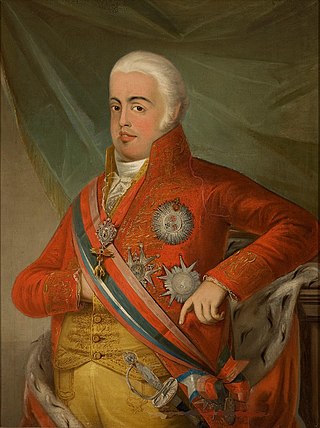
Dom John VI, nicknamed "the Clement", was King of the United Kingdom of Portugal, Brazil and the Algarves from 1816 to 1825. Although the United Kingdom of Portugal ceased to exist de facto beginning in 1822, he remained its monarch de jure between 1822 and 1825. After the recognition of the independence of Brazil under the Treaty of Rio de Janeiro of 1825, he continued as King of Portugal until his death in 1826. Under the same treaty, he also became titular Emperor of Brazil for life, while his son, Emperor Pedro I, was both de facto and de jure the monarch of the newly independent country.
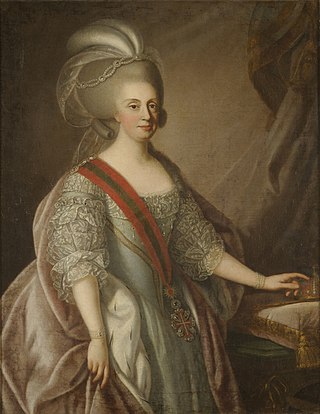
Dona Maria I was Queen of Portugal from 24 February 1777 until her death in 1816. Known as Maria the Pious in Portugal and Maria the Mad in Brazil, she was the first undisputed queen regnant of Portugal and the first monarch of Brazil.

The Most Serene House of Braganza, also known as the Brigantine dynasty, is a dynasty of emperors, kings, princes, and dukes of Portuguese origin which reigned in Europe and the Americas.

Doña Carlota Joaquina Teresa Cayetana of Spain was Queen of Portugal and Brazil as the wife of King Dom John VI. She was the daughter of King Don Charles IV of Spain and Maria Luisa of Parma.
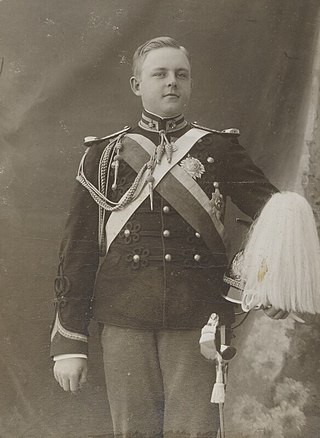
DomLuís Filipe, Prince Royal of Portugal, Duke of Braganza was the eldest son and heir-apparent of King Carlos I of Portugal. He was born in 1887 when his father was still Prince Royal of Portugal and received the usual style of the heirs to the heir of the Portuguese crown: 4th Prince of Beira at birth, with the subsidiary title 14th Duke of Barcelos. After his grandfather King Luís I of Portugal died, he became Prince Royal of Portugal with the subsidiary titles 21st Duke of Braganza, 20th Marquis of Vila Viçosa, 28th count of Barcelos, 25th count of Ourém, 23rd count of Arraiolos and 22nd count of Neiva.
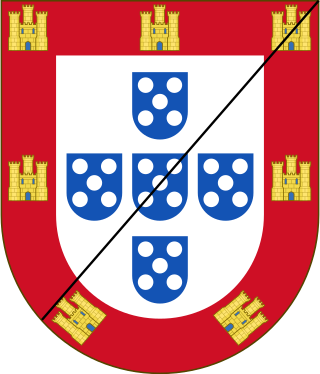
Duke of Aveiro was a Portuguese title of nobility, granted in 1535 by King John III of Portugal to his 4th cousin, John of Lencastre, son of Infante George of Lencastre, a natural son of King John II of Portugal.
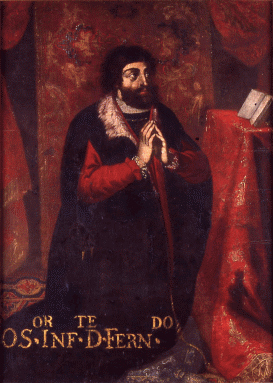
Infante Ferdinand, Duke of Viseu and Beja was the third son of Edward, King of Portugal and his wife Eleanor of Aragon.
The highest hereditary title in the Portuguese nobility. By tradition, there are a total of five royal and seven non-royal dukes in Portugal, out of 28 dukedoms that have ever been created. In the majority of cases, the title of duke was attributed to members of the high nobility, usually relatives of the Portuguese royal family, such as the second son of a monarch.
Constable of Portugal was an office created by King Ferdinand I of Portugal in 1382, to substitute the High Standard-bearer (Alferes-Mor) as the head of the Portuguese Military. It was also referred as the Constable of the Kingdom.
Marquis of Castelo Rodrigo was a title of Portuguese nobility created by Philip II of Portugal on 29 January 1600 for Dom Cristóvão de Moura, 1st Count of Castelo Rodrigo. The Moura family claimed its origin from the re-conquest of Moura from the Moors, during the Reconquista in 1165.

Duke of Caminha was a title created by royal decree, dated 14 December 1620, by King Philip III of Portugal for Dom Miguel Luís de Menezes, 6th Marquis of Vila Real and 8th Count of Vila Real. He was the eldest son of Manuel de Menezes, Duke of Vila Real.

Marquis of Vila Real was a Portuguese title of nobility created by a royal decree, dated from 1 March 1489, by King John II of Portugal, and granted to Dom Pedro de Menezes, also known as Peter II of Menezes, 3rd Count of Vila Real.

Count of Alcoutim was a Portuguese title of nobility, subsidiary to the one of Marquis of Vila Real, created by a royal decree, dated from November 15, 1496, by King John II of Portugal, and granted to Dom Fernando de Menezes, also known as Ferdinand II of Menezes, 2nd Marquis of Vila Real, 4th Count of Vila Real and 2nd Count of Valença.

Count of Valença was a Portuguese title of nobility, created by a royal decree, dated from July 20, 1464, by King Afonso V of Portugal, and granted to Dom Henrique de Menezes, who was already 3rd Count of Viana and 4th Count of Viana.

The Count of Feira was a Portuguese title of nobility created by a royal decree, in 1481, by King Afonso V of Portugal, and granted to D. Rui Pereira, the son of Fernão Pereira, Lord of Santa Maria da Feira.
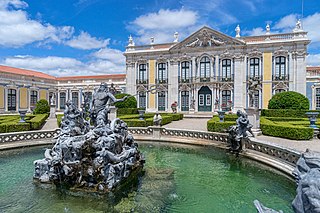
Queluz is a city within the Sintra Municipality, on the Portuguese Riviera, in the Lisbon metropolitan area of Portugal. It is famed as the home of Queluz National Palace, the 18th century pleasure palace of the Portuguese Royal Family, as well as notable institutions like the Portuguese School of Equestrian Art. Queluz had a population 78,273 inhabitants in 2001.

The Bemposta Palace, also known as the Paço da Rainha, is a neoclassical palace in the area of Bemposta, now the civil parish of Pena, in Lisbon. It was originally built for Queen Dowager Catherine of Braganza on her return from London to Lisbon and served for many years as her residence. It was then transferred to the Casa do Infantado, before becoming the residence of John VI of Portugal until his death. After Queen Maria II of Portugal transferred its title to the Army, it became the Portuguese Military Academy.
D. João of Braganza, Duke of Abrantesjure uxoris, more commonly known as João da Bemposta, was a legitimized natural son of Infante Francisco, Duke of Beja. A grandson of King Pedro II of Portugal, and thus a member of the House of Braganza, João held various offices during the reigns of his uncle King João V and cousin Queen Maria I.
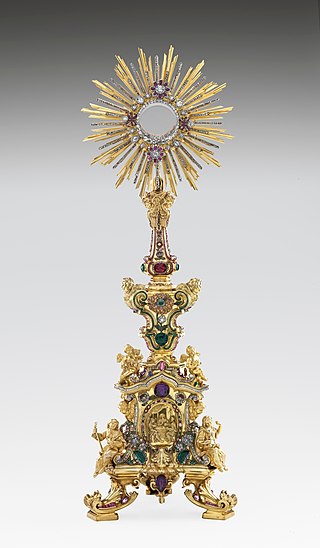
The Bemposta Monstrance is a monstrance dated 1777, designed by architect Mateus Vicente de Oliveira and made by Prussian-born jewelsmith Adam Gottlieb Pollet. It was commissioned by Peter III of Portugal for the Chapel of Bemposta Palace, an estate in the Infante's dominions as Lord of the House of the Infantado.

The Corte Real Palace was a former palace in Lisbon, Portugal. It was constructed by the Corte Real family at the start of the 17th century, and subsequently owned by the Portuguese royal family. It was heavily damaged by fire in 1751, and the remainder was successively destroyed during the 1755 Lisbon earthquake. Today, nothing remains anymore of the palace once considered the most celebrated private palace of Lisbon.